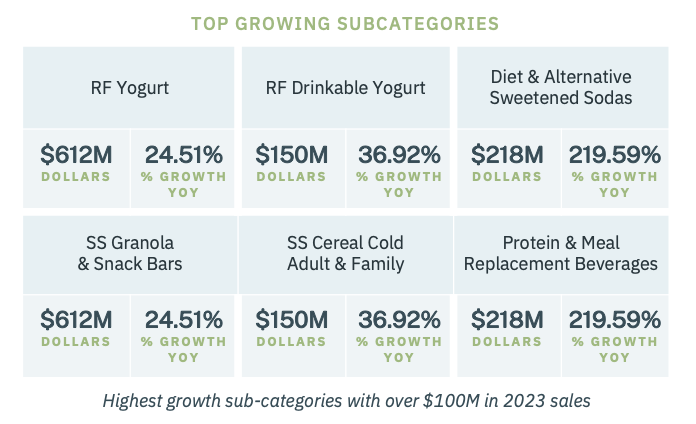Key Takeaways
- Prebiotics stimulate the growth of beneficial microorganisms (probiotics) during the digestion process.
- A majority of Americans believe digestive health is an important health priority.
- They have a wide variety of uses and are beginning to see use across nearly every grocery aisle.
Gut health has been a rising consumer trend for years now, and prebiotic fibers (or just prebiotics) have been a rising star in products related to this movement for nearly a decade! That said, we still see a lot of questions: What are prebiotics? Are they fibers? Are they also probiotic? In this blog post, we hope to talk through some of these concepts and explain why you should expect to continue seeing prebiotics hitting shelves.
What are Prebiotic Fibers?
Prebiotic fibers occupy an interesting middle ground between dietary fibers and probiotics. To date, the FDA has not formally defined what makes something “prebiotic.” However, while they are still being studied, prebiotics can be broadly defined as non-digestible fibers that ferment in the gut and stimulate growth and activity of beneficial intestinal bacteria (aka, probiotics).
It’s important to note that prebiotic fiber is not necessarily the same as dietary fiber which has a specific FDA definition. Essentially, dietary fiber is non-digestible natural or manufactured carbohydrates (the non-digestible part is key here—that’s what separates the scientific definitions of dietary fibers from other carbs we see on nutrition fact panels) that directly provide specific human health benefits from consuming them, such as lowering blood glucose, cholesterol, and blood pressure.
If you recall, one of the defining features of prebiotics is fermentation in the gut which stimulates the growth of probiotics. Since this fermentation requires a few extra steps between the consumption of a prebiotic and the specific benefit of consuming it, the FDA considers fermentation to be a process and not a direct benefit of consumption.
That was a long-winded way to say that all prebiotics are fibers, but prebiotics are not considered dietary fibers unless they provide health benefits from consuming them that are separate from stimulating the growth of probiotics in your gut through fermentation. Further, while prebiotics do not contain probiotics, consuming them alongside probiotics is believed to help supercharge their effects.
Setting legal and scientific definitions aside, it’s worth noting that prebiotic fibers like inulin (not insulin) are extremely common and can be found in foods like garlic, onions, wheat, asparagus, and even bananas. Other examples of prebiotic fibers include:
- Inulin
- Psyllium
- Acacia Fiber
- Glucomannan
- Konjac
- Tapioca Soluble Fiber
Why Prebiotic Fibers Matter
Thankfully, why prebiotics matter is much more straightforward compared to defining them. 40% of Americans have had routine activities disrupted by digestive troubles. Further, nearly 75% said that gut health is important to them, with 24% saying it is the most important aspect of their overall health! With stats like these, it’s no surprise that prebiotics are a nearly 12 billion-dollar industry.
Aside from potentially promoting good gut health, depending on the prebiotic, they can serve many purposes outside of the supplement aisle! For example, acacia fiber is used as a binder and texture additive, konjac (a plant made entirely of fiber and its prebiotic component, glucomannan) is popular as a calorie-free alternative to noodles and rice, and soluble tapioca fiber is frequently used as a low/no calorie sweetener.
High Growth Areas for Prebiotics
Given their many uses and the fact that they are animal-free, frequently allergen-friendly, and suitable for keto and other low-carb diets, it’s no wonder why prebiotics are becoming increasingly popular across several categories and subcategories.
Some of the highest growth subcategories that cleared over $100M in sales last year include:

Some of these are no surprise. Refrigerated traditional and drinkable yogurts have long touted probiotic benefits, so why not add prebiotics into the mix? Similarly, protein and meal replacement liquids, which frequently come in the form of smoothies and shakes, are also prime candidates for adding in a bit of a digestive boost.
However, when we look at the other high-growth categories—shelf-stable cold cereals, granola and snack bars, and prebiotic sodas (the clear breakout star)—it’s clear that Americans are gravitating towards ways to bring prebiotics into their daily lives, whether dairy is involved or not.
Conclusion
The popularity of these products proves many Americans already face gastrointestinal problems, and the ones who don’t would prefer to keep it that way. As awareness of prebiotics rises, expect them to continue to proliferate across the grocery store. After all, you are what you eat!
Healthy bodies require healthy diets, and it all starts from the gut.







